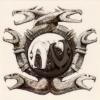And the B-52 is much older than the A-10 and its still a very viable bomber, right?
An idea just occurred to me. Roles of aircraft are often muddled, with the Air Force wanting people to believe that a single plane can fill many nitches. This has usually proven to be quite false; the F-4 Phantom, in Vietnam, was often used as a Close Air Support plane, Air Superiority, bombing, recon, et cetera. Some of these missions require the same performance. For example, an Air Superiority plane and recon plane both might be expected to have high altitute and high speed performance. However, when a high speed plane is tasked with CAS missions, the compromise is not as ideal.
CAS planes have to possess a few qualities to make them successful. The P-47 Thunderbolt, the A-10 Thunderbolt II and (maybe) the Su-25 Frogfoot are all well protected. The A-10 has over 900lbs of titanium protecting the cockpit and vital areas. In addition, the plane is completely symmetrical in that if a rudder, engine or most any other part needs to be replaced, a single part can replace both the let and the right missing pieces. The other quality needed is low speed and high maneuverability. The low speed allows it to prosecute slow moving targets, such as tanks, while the maneuverability not only protects it against anti-aircraft fire, it allows the plane to have a frightingly small turn radius so it can make a second pass very quickly.
The F-35 may possess the maneuverability. Does it have a low stall speed, and is it well protected? This data has not been released, or if it has, is it on par with the A-10? If not, can the A-10 be upgraded to make it useful into the 21st century? Sure. The B-52 will probably still be flying into the 2030s and 2040s, almost a century after it was first introduced.
The specific mission of the A-10 does not need stealth, nor high speed. All the mission requires is a mean, slow plane with a terrible bite.
Edited by 7th_Panzer, 15 September 2005 - 06:31 PM.














